|
Land Cruisers models
are identified by an alphanumeric code. The code consists of the
engine
series designation letter(s) and the frame
designation number separated by a the letter "J." The J may be intended
to indicate Japan as the country of production. For example a 2 door
with short wheel base and a 2F gasoline engine would be a FJ40.
|
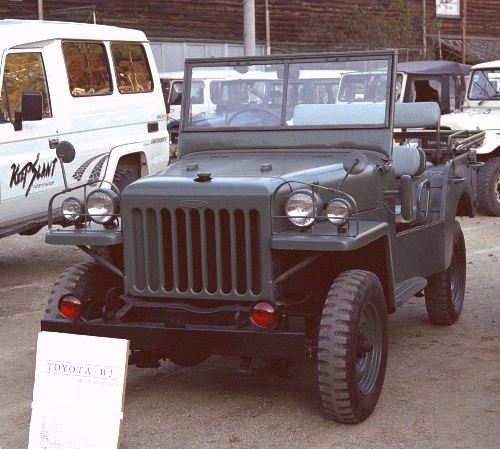 Land
Cruiser BJ (Toyota Jeep) Back in 1950 the American Army contacted the
Toyota Motor Corporation with a request for a 4WD vehicle to be used by
the soldiers and military police stationed in Japan. Toyota took the request
seriously. During the war Toyota had produced a 4WD vehicle named AK10
for the Japanese army. With that experience in their back pocket Toyota
presented, within six months, in August 1950 the Toyota Jeep Model BJ.
It had a two piece windscreen, a vertically ribbed front and its appearance
did not differ much from the Jeep. The engine was a 6-cylinder gasoline,
3.386 liter and 63 kW. It had a 4-speed transmission without synchromesh
and a single range transfer. Land
Cruiser BJ (Toyota Jeep) Back in 1950 the American Army contacted the
Toyota Motor Corporation with a request for a 4WD vehicle to be used by
the soldiers and military police stationed in Japan. Toyota took the request
seriously. During the war Toyota had produced a 4WD vehicle named AK10
for the Japanese army. With that experience in their back pocket Toyota
presented, within six months, in August 1950 the Toyota Jeep Model BJ.
It had a two piece windscreen, a vertically ribbed front and its appearance
did not differ much from the Jeep. The engine was a 6-cylinder gasoline,
3.386 liter and 63 kW. It had a 4-speed transmission without synchromesh
and a single range transfer.
|
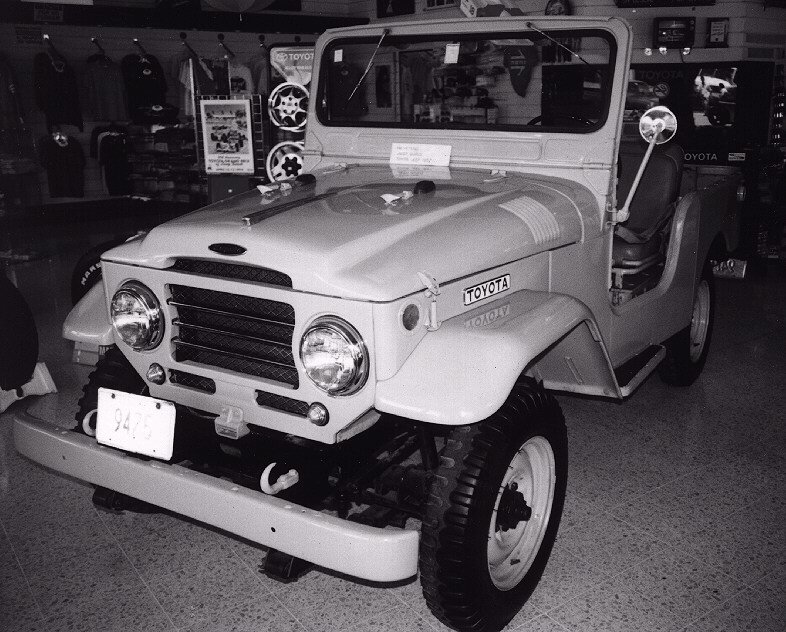 25
Series In 1958 the Land Cruiser took on the familiar body style.
It used the 3.8 liter 6 cylinder gas "F" engine. It had a slightly different
grill and fenders than later 40's. (This example of the FJ25
was found in a Costa Rican Auto dealership.) 25
Series In 1958 the Land Cruiser took on the familiar body style.
It used the 3.8 liter 6 cylinder gas "F" engine. It had a slightly different
grill and fenders than later 40's. (This example of the FJ25
was found in a Costa Rican Auto dealership.)
|
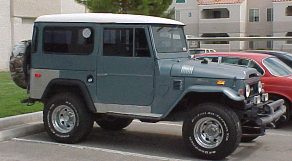 40
Series The 40 Series was produced from 1961 to 1984. This is the classic
Land Cruiser. It is a two door with removable hardtop / softop. Early models
had a 3 speed transmission that was replaced in 1974 with a 4 speed, and
in 1983 with a 5 speed. It is was produced with several engine types. FJ40's
with the 3.8 liter 6 cylinder F engine came to North America around 1963.
FJ40's with the 4.2 liter 2F engine started in 1974. BJ40's with the 3.0
liter 4 cylinder B engine came to Canada from '78-'80 but were offered
elsewhere for longer. BJ40's with the 3.4 liter 3B came to Canada from
'81-'84. See the FAQ for
more detailed information on the various changes to the 40 series Cruisers. 40
Series The 40 Series was produced from 1961 to 1984. This is the classic
Land Cruiser. It is a two door with removable hardtop / softop. Early models
had a 3 speed transmission that was replaced in 1974 with a 4 speed, and
in 1983 with a 5 speed. It is was produced with several engine types. FJ40's
with the 3.8 liter 6 cylinder F engine came to North America around 1963.
FJ40's with the 4.2 liter 2F engine started in 1974. BJ40's with the 3.0
liter 4 cylinder B engine came to Canada from '78-'80 but were offered
elsewhere for longer. BJ40's with the 3.4 liter 3B came to Canada from
'81-'84. See the FAQ for
more detailed information on the various changes to the 40 series Cruisers.
|
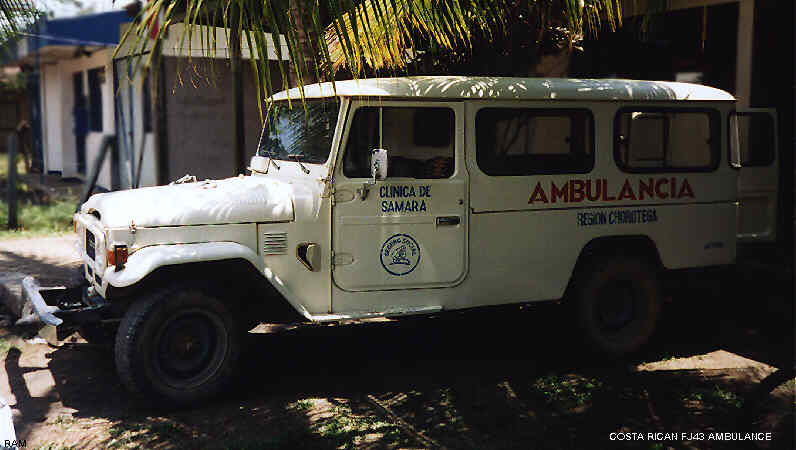 43 Series This is a longer wheelbase version of the 40.
This truck was spotted in Costa Rica. This style was not generally available
in the USA although some were imported discreetly. Australia got
their first FJ45 troopies in 1976, these were all soft top models
with full hard doors. No diesel models until mid 1979 when the H series
6 cylinder diesel was introduced and a hard top model designated
HJ45 arrived. It had 2 body options, 11 seat capacity or 3 seater, hardtop
roof was full length fiberglass. All hardtops had "ambulance" rear
doors, Nippondenso "factory underdash air" was an option. Around
1981 the HJ47 was released with the 2H diesel, padded dash and a change
of color schemes. The HJ47 model continued until about late 1984.
43 Series This is a longer wheelbase version of the 40.
This truck was spotted in Costa Rica. This style was not generally available
in the USA although some were imported discreetly. Australia got
their first FJ45 troopies in 1976, these were all soft top models
with full hard doors. No diesel models until mid 1979 when the H series
6 cylinder diesel was introduced and a hard top model designated
HJ45 arrived. It had 2 body options, 11 seat capacity or 3 seater, hardtop
roof was full length fiberglass. All hardtops had "ambulance" rear
doors, Nippondenso "factory underdash air" was an option. Around
1981 the HJ47 was released with the 2H diesel, padded dash and a change
of color schemes. The HJ47 model continued until about late 1984. |
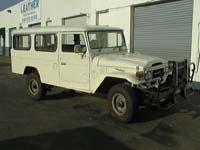 45 Series Trooper
45 Series Trooper
|
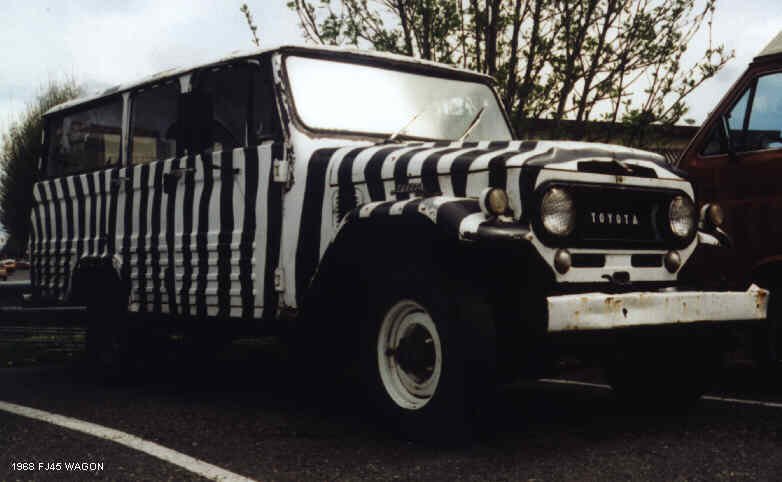 45 Series Wagon The 45 Wagon is quite rare It is similar to the troop
carrier, but has 5 doors.Gifu Body manufactured the body for the 45 Wagon.
45 Series Wagon The 45 Wagon is quite rare It is similar to the troop
carrier, but has 5 doors.Gifu Body manufactured the body for the 45 Wagon.
|
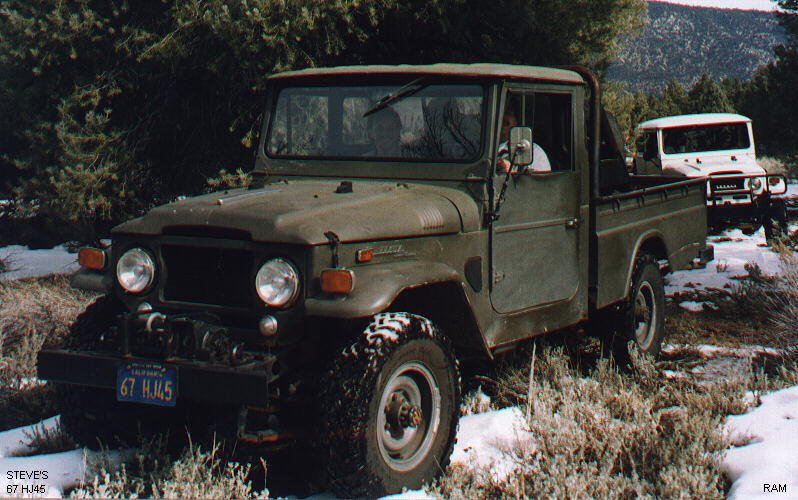 45 Series Pickup The pickup version of the Land Cruiser. 45 LBPU
Square bed with tie down loops on sides, removable hard/soft top. 45 SBPU
Rounded bed with bevel on top rim like a 40. This version had fixed hardtop
until approx. 1964 then removable hardtop.
45 Series Pickup The pickup version of the Land Cruiser. 45 LBPU
Square bed with tie down loops on sides, removable hard/soft top. 45 SBPU
Rounded bed with bevel on top rim like a 40. This version had fixed hardtop
until approx. 1964 then removable hardtop.
|
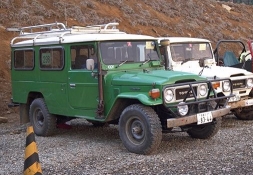 47 Series
47 Series
|
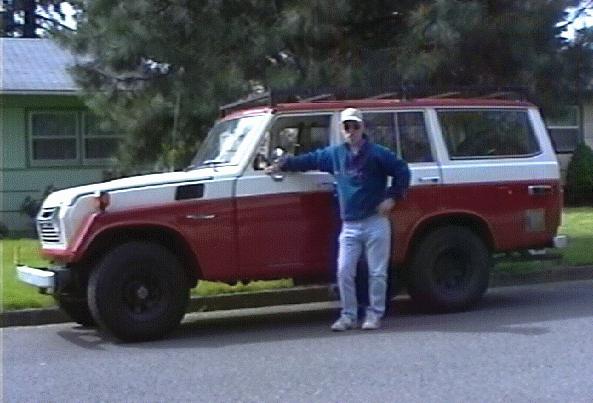 55
Series This model was available in North America from 1969 to 1980.
It appeared with an F engine, and then was replaced with the 2F version
in 1975. It is a station wagon with a narrower appearance than the 40 series. 55
Series This model was available in North America from 1969 to 1980.
It appeared with an F engine, and then was replaced with the 2F version
in 1975. It is a station wagon with a narrower appearance than the 40 series.
|
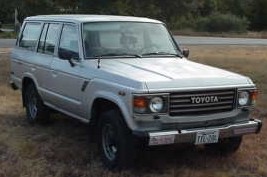 60
Series FJ60's were available from 1980 to 1987 and were equipped
with the 2F Gasoline engine in the USA. BJ60's with the 3B Diesel became
available in Canada in 1984, then they were replaced with with the HJ60
with the 6 cylinder Diesel and a 5 speed transmission from '85-'87
. 60
Series FJ60's were available from 1980 to 1987 and were equipped
with the 2F Gasoline engine in the USA. BJ60's with the 3B Diesel became
available in Canada in 1984, then they were replaced with with the HJ60
with the 6 cylinder Diesel and a 5 speed transmission from '85-'87
.
|
 62
Series This updated version of the 60 series was produced from
1987 to 1989. It can be distinguished from the 60 Series by the 2 pairs
of rectangular headlights. It has the fuel injected 3.9 L 6 cylinder fuel
injected 3F engine and was available only with an automatic transmission
in North America. 62
Series This updated version of the 60 series was produced from
1987 to 1989. It can be distinguished from the 60 Series by the 2 pairs
of rectangular headlights. It has the fuel injected 3.9 L 6 cylinder fuel
injected 3F engine and was available only with an automatic transmission
in North America.
|
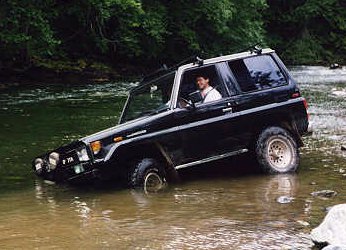 70
Series The 70 series started production in 1985. The picture
shows the LX version with chrome wheels, chrome steps and grill, 'air ride'
front seats, and a folding rear bench seat. The 70 Series shares many features
of the late model 40 series except for the body style, the frame and drive
train very similar. The BJ70 has the 3B 3.4L diesel. This version was not
imported to the United States, and Canada stopped importation of this version
in 1987. The 70 series is equipped with power brakes, power steering, and
5 speed transmission. In Europe and Indonesia, the 70LC "Bandura" was produced
which had coil springs instead of the standard leaf springs, and the smaller
2L-T 2.3L turbo diesel engine. The newer models have a redesigned grill
and come with the 6 cylinder HZJ engine. 70
Series The 70 series started production in 1985. The picture
shows the LX version with chrome wheels, chrome steps and grill, 'air ride'
front seats, and a folding rear bench seat. The 70 Series shares many features
of the late model 40 series except for the body style, the frame and drive
train very similar. The BJ70 has the 3B 3.4L diesel. This version was not
imported to the United States, and Canada stopped importation of this version
in 1987. The 70 series is equipped with power brakes, power steering, and
5 speed transmission. In Europe and Indonesia, the 70LC "Bandura" was produced
which had coil springs instead of the standard leaf springs, and the smaller
2L-T 2.3L turbo diesel engine. The newer models have a redesigned grill
and come with the 6 cylinder HZJ engine.
|
 73 Series
These are commonly called the Mid Wheel Base (MWB)
Cruisers. They came out with the FRP (Fiber Reinforced Plastic) tops.
They are about 12" longer in the wheel base than the SWB 70's. Powered
by the 3F Gasoline engine, or the 3B, the 13BT (basically a turbo
3B), and later the 1HZ (4.2L Diesel), and the 1PZ (a 5 cylinder 3.5L version
of the 1HZ). Some of these (gas only) came with an optional
4 speed Automatic transmission. In Venezuela this model is available
with the 4.5 liter 1FZ Engine used in the 80 Series!
73 Series
These are commonly called the Mid Wheel Base (MWB)
Cruisers. They came out with the FRP (Fiber Reinforced Plastic) tops.
They are about 12" longer in the wheel base than the SWB 70's. Powered
by the 3F Gasoline engine, or the 3B, the 13BT (basically a turbo
3B), and later the 1HZ (4.2L Diesel), and the 1PZ (a 5 cylinder 3.5L version
of the 1HZ). Some of these (gas only) came with an optional
4 speed Automatic transmission. In Venezuela this model is available
with the 4.5 liter 1FZ Engine used in the 80 Series! |
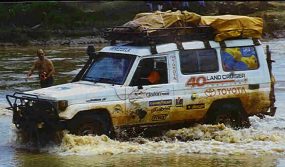 75
Series Troop Carrier 1985 saw the release of the 75 series Troopie
with new body, 2H diesel and 3F petrol engines, this model continued until
1990 with minor changes, again and several after market companies provided
"pop top" camper conversions for this body. The main upgrade in 1990 was
an increase in engine performance, in 1993 the "RV" model was introduced
with some "luxo" options like 6 seats, 4 speaker AM/FM stereo cassette,
extra sub tank, cloth insert seats, front door pockets, power rear door
lock. The 1HZ diesel engine continued on and a new 1FZ-FE 4.5 liter petrol
engine was introduced, also 1993. Integrated Air Conditioning was also
optional for the 75 series troopies. The 75 series has been adapted for
many roles, recreational, mining, ambulances, armored money trucks, hire
campers, extended custom bodies for tour operators etc. The Defense Forces
also use them extensively. 75
Series Troop Carrier 1985 saw the release of the 75 series Troopie
with new body, 2H diesel and 3F petrol engines, this model continued until
1990 with minor changes, again and several after market companies provided
"pop top" camper conversions for this body. The main upgrade in 1990 was
an increase in engine performance, in 1993 the "RV" model was introduced
with some "luxo" options like 6 seats, 4 speaker AM/FM stereo cassette,
extra sub tank, cloth insert seats, front door pockets, power rear door
lock. The 1HZ diesel engine continued on and a new 1FZ-FE 4.5 liter petrol
engine was introduced, also 1993. Integrated Air Conditioning was also
optional for the 75 series troopies. The 75 series has been adapted for
many roles, recreational, mining, ambulances, armored money trucks, hire
campers, extended custom bodies for tour operators etc. The Defense Forces
also use them extensively.
|
 75
Series Pickup This is the "pickup" truck version of the 70. The current
model 70 series trucks have the 4.2l Six cylinder 1HZ Diesel. (Earlier
models had the 5 cylinder diesel 1PZ) This model is being imported into
Canada in small numbers for use in mines in northern Canada. These versions
are stripped versions with split rims and bench seats, and are not DOT
certified for on road use. They are modified with a crew cab in place of
the box to carry mine workers 75
Series Pickup This is the "pickup" truck version of the 70. The current
model 70 series trucks have the 4.2l Six cylinder 1HZ Diesel. (Earlier
models had the 5 cylinder diesel 1PZ) This model is being imported into
Canada in small numbers for use in mines in northern Canada. These versions
are stripped versions with split rims and bench seats, and are not DOT
certified for on road use. They are modified with a crew cab in place of
the box to carry mine workers
|
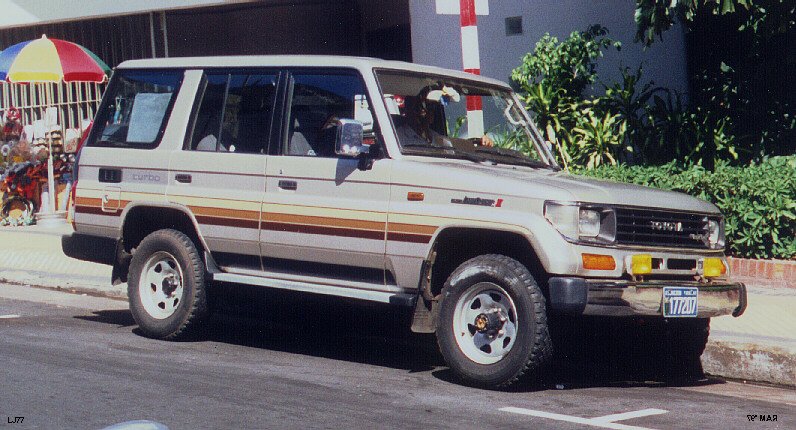 77
Series Wagon somewhere in Brazil. This is an LJ77 light duty
Land Cruiser. The light duty version is known as the Land Cruiser
II. The light duty truck has coil springs instead of leafs, and 8"
differentials like the Hilux rather than the 9.5" ones found on the heavy
duty Land Cruisers. This truck has the 2LT 2.4 Liter Turbo Diesel
engine. 77
Series Wagon somewhere in Brazil. This is an LJ77 light duty
Land Cruiser. The light duty version is known as the Land Cruiser
II. The light duty truck has coil springs instead of leafs, and 8"
differentials like the Hilux rather than the 9.5" ones found on the heavy
duty Land Cruisers. This truck has the 2LT 2.4 Liter Turbo Diesel
engine. |
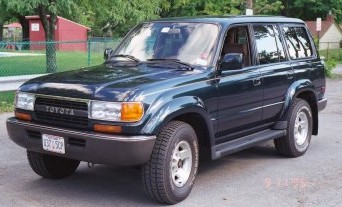 80
Series Features coil spring suspension, full-time 4 wheel drive
with locking center differential and ABS brakes. First introduced in 1991,
it was available in North America with the 3F-E engine. In 1992 the the
engine was replaced by the 4.5 liter 6 cylinder 1FZ-FE engine, DOHC, 24
valves, and electronic fuel injection. In South America, Europe and Australia
it is available with several other
engine types including the 1HD-FT 4.1 liter Six cylinder in-line turbocharged
direct injection SOHC 4 valve turbo diesel engine. 80
Series Features coil spring suspension, full-time 4 wheel drive
with locking center differential and ABS brakes. First introduced in 1991,
it was available in North America with the 3F-E engine. In 1992 the the
engine was replaced by the 4.5 liter 6 cylinder 1FZ-FE engine, DOHC, 24
valves, and electronic fuel injection. In South America, Europe and Australia
it is available with several other
engine types including the 1HD-FT 4.1 liter Six cylinder in-line turbocharged
direct injection SOHC 4 valve turbo diesel engine.
|
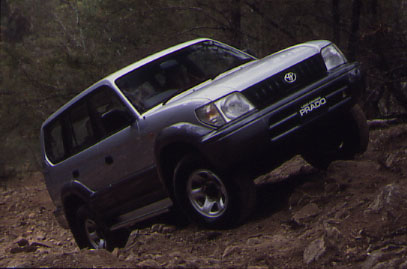 Prado (90 Series) ) For full information read a copy of the Press
release. The Prado (Challenger in Europe) is a replacement for the
light duty (coil spring) version of the 70 series. The Prado, is a luxury
model, with factory: full-time 4wd, IFS & rear coils, airbags, 4 discs,
215/80 on R16x6J rims, velour cloth interior, height adjustable head lights
(required in Germany/Belgium anyway).
Prado (90 Series) ) For full information read a copy of the Press
release. The Prado (Challenger in Europe) is a replacement for the
light duty (coil spring) version of the 70 series. The Prado, is a luxury
model, with factory: full-time 4wd, IFS & rear coils, airbags, 4 discs,
215/80 on R16x6J rims, velour cloth interior, height adjustable head lights
(required in Germany/Belgium anyway).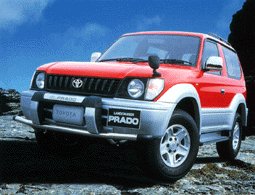 Empty
weight 3 door: 1720kg, load 790, towing 2800. Empty weight 5 door: 1840kg,
load 860, towing 2800. Two engines: 1-KZ-TE: inline 4cyl 3.0L turbo diesel,
96kW/130hp@3600rpm & 295Nm@2000rpm (1Nm=1.5ft-lbs). ?: V6 3.4L, gasoline
190hp, the same as goes into the Tacoma/FunRunner. This model will not
be available in North America. See Willem-Jan
Markerink's Page for more info! Empty
weight 3 door: 1720kg, load 790, towing 2800. Empty weight 5 door: 1840kg,
load 860, towing 2800. Two engines: 1-KZ-TE: inline 4cyl 3.0L turbo diesel,
96kW/130hp@3600rpm & 295Nm@2000rpm (1Nm=1.5ft-lbs). ?: V6 3.4L, gasoline
190hp, the same as goes into the Tacoma/FunRunner. This model will not
be available in North America. See Willem-Jan
Markerink's Page for more info!
|
 100
Series Successor to the 80 Series. This model should be released
in the 1988 model year. The USA version will be assembled in
California, as the Lexus LX470 with a 4.7L V8. The front live
axle has been replaced with an independent front suspension and torsion
bars. The 100 series is too big and top-heavy to be much of
a performer on-road, and the IFS makes it unsuited for anything but "week-end
warrior" off road use. Also due to the IFS, the front locker is no
longer an option. See Willam
Jans page for more information. 100
Series Successor to the 80 Series. This model should be released
in the 1988 model year. The USA version will be assembled in
California, as the Lexus LX470 with a 4.7L V8. The front live
axle has been replaced with an independent front suspension and torsion
bars. The 100 series is too big and top-heavy to be much of
a performer on-road, and the IFS makes it unsuited for anything but "week-end
warrior" off road use. Also due to the IFS, the front locker is no
longer an option. See Willam
Jans page for more information. |
| 105 Series The real heir to the Land Cruiser throne.
This is for markets where a Land Cruiser is a working vehicle, not a status
symbol. The running gear is little changed from the 80 Series (that
is, the solid front axle and coil springs are retained) This vehicle
will not be available in North America. |
  Mega-Cruiser
This is a proof of concept vehicle to compete with the Hummer.
This model sees limited distribution in Japan, and is not available in
North America. It uses a 4.1 Liter direct injection intercooled turbo Diesel
,4 speed automatic transmission with lock-up clutch ,Full-time 4WD with
2 speed transfer case, 4 Wheel independent double wishbone suspension ,Front
& Rear Limited slip differentials with locks, Axles with hub reduction
gears and 37" tires, Minimum ground clearance 450 mm ,Counterphase four
wheel steering ,Turning radius 11.8 meters, Rear tire air pressure adjuster,
Inboard 4 wheel disc brakes. Check out the Toyota Japan site for more on
the Mega
Cruiser. Mega-Cruiser
This is a proof of concept vehicle to compete with the Hummer.
This model sees limited distribution in Japan, and is not available in
North America. It uses a 4.1 Liter direct injection intercooled turbo Diesel
,4 speed automatic transmission with lock-up clutch ,Full-time 4WD with
2 speed transfer case, 4 Wheel independent double wishbone suspension ,Front
& Rear Limited slip differentials with locks, Axles with hub reduction
gears and 37" tires, Minimum ground clearance 450 mm ,Counterphase four
wheel steering ,Turning radius 11.8 meters, Rear tire air pressure adjuster,
Inboard 4 wheel disc brakes. Check out the Toyota Japan site for more on
the Mega
Cruiser.
|
 Bandeirante Bandeirante  This
line of Land Cruisers is currently manufactured under license by
Toyota in Brazil. Earlier models used a diesel engine manufactured
by Mercedes Benz. Current models use the Toyota14B
Engine. Body panels are produced in Brazil from Toyota dies. This
line of Land Cruisers is currently manufactured under license by
Toyota in Brazil. Earlier models used a diesel engine manufactured
by Mercedes Benz. Current models use the Toyota14B
Engine. Body panels are produced in Brazil from Toyota dies. |
 |
  |
|
|
 Land
Cruiser BJ (Toyota Jeep) Back in 1950 the American Army contacted the
Toyota Motor Corporation with a request for a 4WD vehicle to be used by
the soldiers and military police stationed in Japan. Toyota took the request
seriously. During the war Toyota had produced a 4WD vehicle named AK10
for the Japanese army. With that experience in their back pocket Toyota
presented, within six months, in August 1950 the Toyota Jeep Model BJ.
It had a two piece windscreen, a vertically ribbed front and its appearance
did not differ much from the Jeep. The engine was a 6-cylinder gasoline,
3.386 liter and 63 kW. It had a 4-speed transmission without synchromesh
and a single range transfer.
Land
Cruiser BJ (Toyota Jeep) Back in 1950 the American Army contacted the
Toyota Motor Corporation with a request for a 4WD vehicle to be used by
the soldiers and military police stationed in Japan. Toyota took the request
seriously. During the war Toyota had produced a 4WD vehicle named AK10
for the Japanese army. With that experience in their back pocket Toyota
presented, within six months, in August 1950 the Toyota Jeep Model BJ.
It had a two piece windscreen, a vertically ribbed front and its appearance
did not differ much from the Jeep. The engine was a 6-cylinder gasoline,
3.386 liter and 63 kW. It had a 4-speed transmission without synchromesh
and a single range transfer.  25
Series In 1958 the Land Cruiser took on the familiar body style.
It used the 3.8 liter 6 cylinder gas "F" engine. It had a slightly different
grill and fenders than later 40's. (This example of the FJ25
was found in a Costa Rican Auto dealership.)
25
Series In 1958 the Land Cruiser took on the familiar body style.
It used the 3.8 liter 6 cylinder gas "F" engine. It had a slightly different
grill and fenders than later 40's. (This example of the FJ25
was found in a Costa Rican Auto dealership.)  40
Series The 40 Series was produced from 1961 to 1984. This is the classic
Land Cruiser. It is a two door with removable hardtop / softop. Early models
had a 3 speed transmission that was replaced in 1974 with a 4 speed, and
in 1983 with a 5 speed. It is was produced with several engine types. FJ40's
with the 3.8 liter 6 cylinder F engine came to North America around 1963.
FJ40's with the 4.2 liter 2F engine started in 1974. BJ40's with the 3.0
liter 4 cylinder B engine came to Canada from '78-'80 but were offered
elsewhere for longer. BJ40's with the 3.4 liter 3B came to Canada from
'81-'84. See the FAQ for
more detailed information on the various changes to the 40 series Cruisers.
40
Series The 40 Series was produced from 1961 to 1984. This is the classic
Land Cruiser. It is a two door with removable hardtop / softop. Early models
had a 3 speed transmission that was replaced in 1974 with a 4 speed, and
in 1983 with a 5 speed. It is was produced with several engine types. FJ40's
with the 3.8 liter 6 cylinder F engine came to North America around 1963.
FJ40's with the 4.2 liter 2F engine started in 1974. BJ40's with the 3.0
liter 4 cylinder B engine came to Canada from '78-'80 but were offered
elsewhere for longer. BJ40's with the 3.4 liter 3B came to Canada from
'81-'84. See the FAQ for
more detailed information on the various changes to the 40 series Cruisers. 43 Series This is a longer wheelbase version of the 40.
This truck was spotted in Costa Rica. This style was not generally available
in the USA although some were imported discreetly. Australia got
their first FJ45 troopies in 1976, these were all soft top models
with full hard doors. No diesel models until mid 1979 when the H series
6 cylinder diesel was introduced and a hard top model designated
HJ45 arrived. It had 2 body options, 11 seat capacity or 3 seater, hardtop
roof was full length fiberglass. All hardtops had "ambulance" rear
doors, Nippondenso "factory underdash air" was an option. Around
1981 the HJ47 was released with the 2H diesel, padded dash and a change
of color schemes. The HJ47 model continued until about late 1984.
43 Series This is a longer wheelbase version of the 40.
This truck was spotted in Costa Rica. This style was not generally available
in the USA although some were imported discreetly. Australia got
their first FJ45 troopies in 1976, these were all soft top models
with full hard doors. No diesel models until mid 1979 when the H series
6 cylinder diesel was introduced and a hard top model designated
HJ45 arrived. It had 2 body options, 11 seat capacity or 3 seater, hardtop
roof was full length fiberglass. All hardtops had "ambulance" rear
doors, Nippondenso "factory underdash air" was an option. Around
1981 the HJ47 was released with the 2H diesel, padded dash and a change
of color schemes. The HJ47 model continued until about late 1984.  45 Series Trooper
45 Series Trooper  45 Series Wagon The 45 Wagon is quite rare It is similar to the troop
carrier, but has 5 doors.Gifu Body manufactured the body for the 45 Wagon.
45 Series Wagon The 45 Wagon is quite rare It is similar to the troop
carrier, but has 5 doors.Gifu Body manufactured the body for the 45 Wagon.  45 Series Pickup The pickup version of the Land Cruiser. 45 LBPU
Square bed with tie down loops on sides, removable hard/soft top. 45 SBPU
Rounded bed with bevel on top rim like a 40. This version had fixed hardtop
until approx. 1964 then removable hardtop.
45 Series Pickup The pickup version of the Land Cruiser. 45 LBPU
Square bed with tie down loops on sides, removable hard/soft top. 45 SBPU
Rounded bed with bevel on top rim like a 40. This version had fixed hardtop
until approx. 1964 then removable hardtop. 47 Series
47 Series  55
Series This model was available in North America from 1969 to 1980.
It appeared with an F engine, and then was replaced with the 2F version
in 1975. It is a station wagon with a narrower appearance than the 40 series.
55
Series This model was available in North America from 1969 to 1980.
It appeared with an F engine, and then was replaced with the 2F version
in 1975. It is a station wagon with a narrower appearance than the 40 series. 60
Series FJ60's were available from 1980 to 1987 and were equipped
with the 2F Gasoline engine in the USA. BJ60's with the 3B Diesel became
available in Canada in 1984, then they were replaced with with the HJ60
with the 6 cylinder Diesel and a 5 speed transmission from '85-'87
.
60
Series FJ60's were available from 1980 to 1987 and were equipped
with the 2F Gasoline engine in the USA. BJ60's with the 3B Diesel became
available in Canada in 1984, then they were replaced with with the HJ60
with the 6 cylinder Diesel and a 5 speed transmission from '85-'87
. 62
Series This updated version of the 60 series was produced from
1987 to 1989. It can be distinguished from the 60 Series by the 2 pairs
of rectangular headlights. It has the fuel injected 3.9 L 6 cylinder fuel
injected 3F engine and was available only with an automatic transmission
in North America.
62
Series This updated version of the 60 series was produced from
1987 to 1989. It can be distinguished from the 60 Series by the 2 pairs
of rectangular headlights. It has the fuel injected 3.9 L 6 cylinder fuel
injected 3F engine and was available only with an automatic transmission
in North America. 70
Series The 70 series started production in 1985. The picture
shows the LX version with chrome wheels, chrome steps and grill, 'air ride'
front seats, and a folding rear bench seat. The 70 Series shares many features
of the late model 40 series except for the body style, the frame and drive
train very similar. The BJ70 has the 3B 3.4L diesel. This version was not
imported to the United States, and Canada stopped importation of this version
in 1987. The 70 series is equipped with power brakes, power steering, and
5 speed transmission. In Europe and Indonesia, the 70LC "Bandura" was produced
which had coil springs instead of the standard leaf springs, and the smaller
2L-T 2.3L turbo diesel engine. The newer models have a redesigned grill
and come with the 6 cylinder HZJ engine.
70
Series The 70 series started production in 1985. The picture
shows the LX version with chrome wheels, chrome steps and grill, 'air ride'
front seats, and a folding rear bench seat. The 70 Series shares many features
of the late model 40 series except for the body style, the frame and drive
train very similar. The BJ70 has the 3B 3.4L diesel. This version was not
imported to the United States, and Canada stopped importation of this version
in 1987. The 70 series is equipped with power brakes, power steering, and
5 speed transmission. In Europe and Indonesia, the 70LC "Bandura" was produced
which had coil springs instead of the standard leaf springs, and the smaller
2L-T 2.3L turbo diesel engine. The newer models have a redesigned grill
and come with the 6 cylinder HZJ engine.  73 Series
These are commonly called the Mid Wheel Base (MWB)
Cruisers. They came out with the FRP (Fiber Reinforced Plastic) tops.
They are about 12" longer in the wheel base than the SWB 70's. Powered
by the 3F Gasoline engine, or the 3B, the 13BT (basically a turbo
3B), and later the 1HZ (4.2L Diesel), and the 1PZ (a 5 cylinder 3.5L version
of the 1HZ). Some of these (gas only) came with an optional
4 speed Automatic transmission. In Venezuela this model is available
with the 4.5 liter 1FZ Engine used in the 80 Series!
73 Series
These are commonly called the Mid Wheel Base (MWB)
Cruisers. They came out with the FRP (Fiber Reinforced Plastic) tops.
They are about 12" longer in the wheel base than the SWB 70's. Powered
by the 3F Gasoline engine, or the 3B, the 13BT (basically a turbo
3B), and later the 1HZ (4.2L Diesel), and the 1PZ (a 5 cylinder 3.5L version
of the 1HZ). Some of these (gas only) came with an optional
4 speed Automatic transmission. In Venezuela this model is available
with the 4.5 liter 1FZ Engine used in the 80 Series! 75
Series Troop Carrier 1985 saw the release of the 75 series Troopie
with new body, 2H diesel and 3F petrol engines, this model continued until
1990 with minor changes, again and several after market companies provided
"pop top" camper conversions for this body. The main upgrade in 1990 was
an increase in engine performance, in 1993 the "RV" model was introduced
with some "luxo" options like 6 seats, 4 speaker AM/FM stereo cassette,
extra sub tank, cloth insert seats, front door pockets, power rear door
lock. The 1HZ diesel engine continued on and a new 1FZ-FE 4.5 liter petrol
engine was introduced, also 1993. Integrated Air Conditioning was also
optional for the 75 series troopies. The 75 series has been adapted for
many roles, recreational, mining, ambulances, armored money trucks, hire
campers, extended custom bodies for tour operators etc. The Defense Forces
also use them extensively.
75
Series Troop Carrier 1985 saw the release of the 75 series Troopie
with new body, 2H diesel and 3F petrol engines, this model continued until
1990 with minor changes, again and several after market companies provided
"pop top" camper conversions for this body. The main upgrade in 1990 was
an increase in engine performance, in 1993 the "RV" model was introduced
with some "luxo" options like 6 seats, 4 speaker AM/FM stereo cassette,
extra sub tank, cloth insert seats, front door pockets, power rear door
lock. The 1HZ diesel engine continued on and a new 1FZ-FE 4.5 liter petrol
engine was introduced, also 1993. Integrated Air Conditioning was also
optional for the 75 series troopies. The 75 series has been adapted for
many roles, recreational, mining, ambulances, armored money trucks, hire
campers, extended custom bodies for tour operators etc. The Defense Forces
also use them extensively.  75
Series Pickup This is the "pickup" truck version of the 70. The current
model 70 series trucks have the 4.2l Six cylinder 1HZ Diesel. (Earlier
models had the 5 cylinder diesel 1PZ) This model is being imported into
Canada in small numbers for use in mines in northern Canada. These versions
are stripped versions with split rims and bench seats, and are not DOT
certified for on road use. They are modified with a crew cab in place of
the box to carry mine workers
75
Series Pickup This is the "pickup" truck version of the 70. The current
model 70 series trucks have the 4.2l Six cylinder 1HZ Diesel. (Earlier
models had the 5 cylinder diesel 1PZ) This model is being imported into
Canada in small numbers for use in mines in northern Canada. These versions
are stripped versions with split rims and bench seats, and are not DOT
certified for on road use. They are modified with a crew cab in place of
the box to carry mine workers 77
Series Wagon somewhere in Brazil. This is an LJ77 light duty
Land Cruiser. The light duty version is known as the Land Cruiser
II. The light duty truck has coil springs instead of leafs, and 8"
differentials like the Hilux rather than the 9.5" ones found on the heavy
duty Land Cruisers. This truck has the 2LT 2.4 Liter Turbo Diesel
engine.
77
Series Wagon somewhere in Brazil. This is an LJ77 light duty
Land Cruiser. The light duty version is known as the Land Cruiser
II. The light duty truck has coil springs instead of leafs, and 8"
differentials like the Hilux rather than the 9.5" ones found on the heavy
duty Land Cruisers. This truck has the 2LT 2.4 Liter Turbo Diesel
engine. 80
Series Features coil spring suspension, full-time 4 wheel drive
with locking center differential and ABS brakes. First introduced in 1991,
it was available in North America with the 3F-E engine. In 1992 the the
engine was replaced by the 4.5 liter 6 cylinder 1FZ-FE engine, DOHC, 24
valves, and electronic fuel injection. In South America, Europe and Australia
it is available with several other
engine types including the 1HD-FT 4.1 liter Six cylinder in-line turbocharged
direct injection SOHC 4 valve turbo diesel engine.
80
Series Features coil spring suspension, full-time 4 wheel drive
with locking center differential and ABS brakes. First introduced in 1991,
it was available in North America with the 3F-E engine. In 1992 the the
engine was replaced by the 4.5 liter 6 cylinder 1FZ-FE engine, DOHC, 24
valves, and electronic fuel injection. In South America, Europe and Australia
it is available with several other
engine types including the 1HD-FT 4.1 liter Six cylinder in-line turbocharged
direct injection SOHC 4 valve turbo diesel engine.  Prado (90 Series) ) For full information read a copy of the Press
release. The Prado (Challenger in Europe) is a replacement for the
light duty (coil spring) version of the 70 series. The Prado, is a luxury
model, with factory: full-time 4wd, IFS & rear coils, airbags, 4 discs,
215/80 on R16x6J rims, velour cloth interior, height adjustable head lights
(required in Germany/Belgium anyway).
Prado (90 Series) ) For full information read a copy of the Press
release. The Prado (Challenger in Europe) is a replacement for the
light duty (coil spring) version of the 70 series. The Prado, is a luxury
model, with factory: full-time 4wd, IFS & rear coils, airbags, 4 discs,
215/80 on R16x6J rims, velour cloth interior, height adjustable head lights
(required in Germany/Belgium anyway). Empty
weight 3 door: 1720kg, load 790, towing 2800. Empty weight 5 door: 1840kg,
load 860, towing 2800. Two engines: 1-KZ-TE: inline 4cyl 3.0L turbo diesel,
96kW/130hp@3600rpm & 295Nm@2000rpm (1Nm=1.5ft-lbs). ?: V6 3.4L, gasoline
190hp, the same as goes into the Tacoma/FunRunner. This model will not
be available in North America. See Willem-Jan
Markerink's Page for more info!
Empty
weight 3 door: 1720kg, load 790, towing 2800. Empty weight 5 door: 1840kg,
load 860, towing 2800. Two engines: 1-KZ-TE: inline 4cyl 3.0L turbo diesel,
96kW/130hp@3600rpm & 295Nm@2000rpm (1Nm=1.5ft-lbs). ?: V6 3.4L, gasoline
190hp, the same as goes into the Tacoma/FunRunner. This model will not
be available in North America. See Willem-Jan
Markerink's Page for more info! 100
Series Successor to the 80 Series. This model should be released
in the 1988 model year. The USA version will be assembled in
California, as the Lexus LX470 with a 4.7L V8. The front live
axle has been replaced with an independent front suspension and torsion
bars. The 100 series is too big and top-heavy to be much of
a performer on-road, and the IFS makes it unsuited for anything but "week-end
warrior" off road use. Also due to the IFS, the front locker is no
longer an option. See Willam
Jans page for more information.
100
Series Successor to the 80 Series. This model should be released
in the 1988 model year. The USA version will be assembled in
California, as the Lexus LX470 with a 4.7L V8. The front live
axle has been replaced with an independent front suspension and torsion
bars. The 100 series is too big and top-heavy to be much of
a performer on-road, and the IFS makes it unsuited for anything but "week-end
warrior" off road use. Also due to the IFS, the front locker is no
longer an option. See Willam
Jans page for more information.
 Mega-Cruiser
This is a proof of concept vehicle to compete with the Hummer.
This model sees limited distribution in Japan, and is not available in
North America. It uses a 4.1 Liter direct injection intercooled turbo Diesel
,4 speed automatic transmission with lock-up clutch ,Full-time 4WD with
2 speed transfer case, 4 Wheel independent double wishbone suspension ,Front
& Rear Limited slip differentials with locks, Axles with hub reduction
gears and 37" tires, Minimum ground clearance 450 mm ,Counterphase four
wheel steering ,Turning radius 11.8 meters, Rear tire air pressure adjuster,
Inboard 4 wheel disc brakes. Check out the Toyota Japan site for more on
the Mega
Cruiser.
Mega-Cruiser
This is a proof of concept vehicle to compete with the Hummer.
This model sees limited distribution in Japan, and is not available in
North America. It uses a 4.1 Liter direct injection intercooled turbo Diesel
,4 speed automatic transmission with lock-up clutch ,Full-time 4WD with
2 speed transfer case, 4 Wheel independent double wishbone suspension ,Front
& Rear Limited slip differentials with locks, Axles with hub reduction
gears and 37" tires, Minimum ground clearance 450 mm ,Counterphase four
wheel steering ,Turning radius 11.8 meters, Rear tire air pressure adjuster,
Inboard 4 wheel disc brakes. Check out the Toyota Japan site for more on
the Mega
Cruiser.